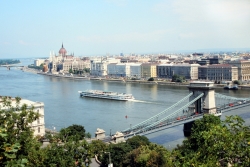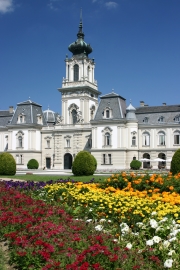Hungary
The Jewel of Eastern Europe: Hungary
Once upon a time, Hungary and its capital at Budapest were
Europe's gateway to the mystical lands of the East. Today, Hungary
retains its enchantment while proving a most wonderful destination
for travellers who are anxious to sample a unique culture that
retains its old-world charm. The following article offers a wide
array of Hungarian enticements that world travellers are sure to
remember.

Széchenyi Chain Bridge over River Danube
Budapest is the heart of Hungary; the picturesque Danube River,
or Duna as Hungarians call it, that travels southward into the city
from Vienna divides this truly international city of elegant gothic
and historic architecture. The Buda side of the city is hilly and
primarily residential. The hills look down onto the river and the
flat Pest side of the city where the Parliament Building sits
enthroned on the river's edge. Several bridges span the great river
including the famous Lion Bridge, also known as the Chain Bridge.
The Danube has many islands and when visiting Budapest, be sure to
visit the therapeutic springs of Margaret Island.

Capital: Budapest
Languages: Hungarian
Time: GMT +1 hr
Currency: Forint (HUF)
While Buda and Pest did not officially merge until 1873, the
site of this city is truly ancient. Excavators have uncovered
evidence of Bronze and Iron Age settlements. The area was also
heavily occupied by Celts and Romans. Hungary was not known as a
state until 896 A.D. when the seven tribes of the Magyars united
under one leader. It may be interesting to know that Budapest is
today considered one of Europe's most beloved and beautiful capital
cities. Castle Hill on the Buda side of the city was declared a
World Heritage Site in 1987. This old world district is like
stepping back in time to Renaissance days. Be sure to visit Matyas
Church and the many outdoor markets that dot the area.
While Budapest offers much of what Hungary has to offer in the
way of national customs and cuisine (think paprika, hearty goulash,
and unbelievable café pastries!), the rest of the country is quite
breathtaking. Hungary covers an area of about 35,900 square miles.
The country is situated within a low basin called the middle Danube
depression, but it literally has something for every scenic taste:
mountains, plains, forests, rivers and lakes. One of the most
famous sections of the country is the Great Plain which is the
largest. Wild horses once roamed this region, but today it is the
agricultural bread-basket of the nation. Some of this area is used
for grazing and the hilly areas are covered by vineyards.

Castle in Keszthely on the shore
of Lake Balaton
Many travellers to Hungary flock to Lake Balaton located in the
west. This beautiful lake is ideal for swimming and sailing as it
is partially fed by hot springs. Many spas and resorts dot this
region. Naturalists find much amusement by visiting the nearby
wetlands and vineyards also can be found throughout this area.
Other Hungarian places of interest include Debrecen (Hungary's
second largest city), Aggtelek National Park (located in the
Northern Highlands), Hortobagy wetland region (in the Great Plain),
Tokaji wine region, Fisherman's Bastion (Budapest) as well as the
many villages that range throughout the country.
Before visiting Hungary, it may be useful to learn some
Hungarian phrases. The language is considered difficult by many,
but many of Budapest's hotels and restaurants are well-versed in
English. Also, immerse yourself in a bit of Hungarian history which
reflects a colourful cast of characters that includes the likes of
Vlad the Impaler and Attila the Hun. Or, listen to the works of
classical Hungarian composers like Franz Liszt or Bela Bartok. This
country is bound to please a wide range of travellers with its
friendly people and rich culture.